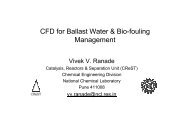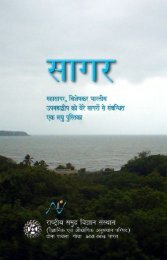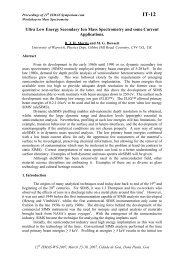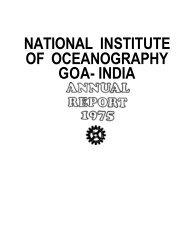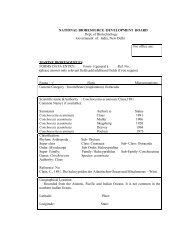1980 - National Institute of Oceanography
1980 - National Institute of Oceanography
1980 - National Institute of Oceanography
You also want an ePaper? Increase the reach of your titles
YUMPU automatically turns print PDFs into web optimized ePapers that Google loves.
3.2<br />
Chemical <strong>Oceanography</strong><br />
3.2.1 Chemical studies in the coastal and <strong>of</strong>fshore waters <strong>of</strong> the Arabian<br />
Sea and Bay <strong>of</strong> Bengal<br />
3.2.2 Drugs from the sea<br />
3.2.3 Protection <strong>of</strong> marine environment and monitoring <strong>of</strong> pollutants along<br />
the Indian coast<br />
3.2.4 Characteristics <strong>of</strong> the estuarine regions <strong>of</strong> major rivers <strong>of</strong> India<br />
The major concern <strong>of</strong> chemical oceanographers is to determine the chemistry<br />
<strong>of</strong> the marine environment and the changes therein induced by natural and man<br />
made activities. Studies on the marine environment also include the determination<br />
<strong>of</strong> the amount <strong>of</strong> organic carbon present in the surface waters, the distribution,<br />
nature and biochemistry <strong>of</strong> marine compounds in marine fauna and flora thereby<br />
identifying new drug resources, and pollution and related aspects like the protection<br />
and control <strong>of</strong> oil pollution, sewage and industrial discharge. These studies were<br />
carried out under four projects and the summary <strong>of</strong> each is given below.<br />
3.2.1 Chemical studies in the coastal and <strong>of</strong>fshore waters <strong>of</strong> the Arabian Sea and Bay<br />
<strong>of</strong> Bengal<br />
The work under this project was carried out at headquarters as well as at<br />
Regional Centre, Cochin.<br />
1. Chemical characteristics <strong>of</strong> the Andaman Sea and Bay <strong>of</strong> Bengal<br />
During the cruises in the southern Bay <strong>of</strong> Bengal from 78°E to 98°30'E, hydrographic<br />
stations were worked at 1 degree intervals. In the Andaman Sea almost all the<br />
stations worked during the cruises 51 and 52 in 1979 were repeated in <strong>1980</strong> and in addition<br />
70 new stations were occupied to study the changes that might have taken place during<br />
the course <strong>of</strong> the year. A total number <strong>of</strong> 4152 analyses were carried out on board and<br />
317 samples were collected for the analysis <strong>of</strong> major ions in the shore laboratory.<br />
In the upper 50-75 m, <strong>of</strong> the entire Andaman Seas the concentrations <strong>of</strong> nitrates,<br />
phosphates and silicates were low. These were associated with high oxygen and pH-<br />
Nitrite was detected only between 50 and 75 m depth. A thick oxygen minimum layer<br />
extended from 100 m to 1000 m. In <strong>1980</strong>, the concentrations <strong>of</strong> nutrients increased with<br />
simultaneous decrease in the oxygen and pH. At a station in the Malacca Strait, north <strong>of</strong><br />
27



